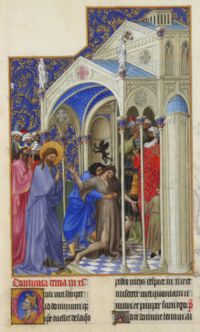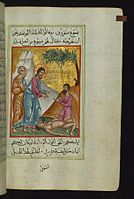
The miracles of Jesus are miraculous deeds attributed to Jesus in Christian and Islamic texts. The majority are faith healings, exorcisms, resurrections, and control over nature.

The life of Jesus is primarily outlined in the four canonical gospels, which includes his genealogy and nativity, public ministry, passion, prophecy, resurrection and ascension. Other parts of the New Testament – such as the Pauline epistles which were likely written within 20 to 30 years of each other, and which include references to key episodes in the life of Jesus, such as the Last Supper, and the Acts of the Apostles, which includes more references to the Ascension episode than the canonical gospels also expound upon the life of Jesus. In addition to these biblical texts, there are extra-biblical texts that make reference to certain events in the life of Jesus, such as Josephus on Jesus and Tacitus on Christ.

Mark 9 is the ninth chapter of the Gospel of Mark in the New Testament of the Christian Bible. It begins with Jesus' prediction that "I tell you the truth, some who are standing here will not taste death before they see that the kingdom of God has come with power". The chapter then recounts the transfiguration of Jesus, a healing miracle, and Jesus' teaching about the return of Elijah, humility and temptation.

The ministry of Jesus, in the canonical gospels, begins with his baptism near the River Jordan by John the Baptist, and ends in Jerusalem in Judea, following the Last Supper with his disciples. The Gospel of Luke states that Jesus was "about 30 years of age" at the start of his ministry. A chronology of Jesus typically sets the date of the start of his ministry at around AD 27–29 and the end in the range AD 30–36.

Matthew 17 is the seventeenth chapter in the Gospel of Matthew in the New Testament section of the Christian Bible. Jesus continues his final journey to Jerusalem ministering through Galilee. William Robertson Nicoll identifies "three impressive tableaux" in this chapter: the transfiguration, the epileptic boy and the temple tribute.

Luke 8 is the eighth chapter of the Gospel of Luke in the New Testament of the Christian Bible. The book containing this chapter is anonymous but early Christian tradition uniformly affirmed that Luke the Evangelist, a companion of Paul the Apostle on his missionary journeys, composed both this Gospel and the Acts of the Apostles. This chapter mentions the women who supported Jesus and records some of the great miracles he performed, as well as several parables told by him.

In Christianity, the Confession of Peter refers to an episode in the New Testament in which the Apostle Peter proclaims Jesus to be the Christ. The proclamation is described in the three Synoptic Gospels: Matthew 16:13–20, Mark 8:27–30 and Luke 9:18–21. Depending on which gospel one reads, Peter either says: 'You are the Messiah' or 'the Christ' ; or 'You are the Messiah, the Son of the living God',, or 'God's Messiah' or 'The Christ of God'.
Matthew 11:1 is the first verse in the eleventh chapter of the Gospel of Matthew in the New Testament.
Matthew 9:28 is a verse in the ninth chapter of the Gospel of Matthew in the New Testament.

Matthew 8:10 is the tenth verse of the eighth chapter of the Gospel of Matthew in the New Testament. This verse continues the miracle story of healing the centurion's servant, the second of a series of miracles in Matthew.

Matthew 8:22 is the 22nd verse in the eighth chapter of the Gospel of Matthew in the New Testament of the Christian Bible.
Matthew 9:34 is a verse in the ninth chapter of the Gospel of Matthew in the New Testament.
Matthew 12:22 is the 22nd verse in the twelfth chapter of the Gospel of Matthew in the New Testament.
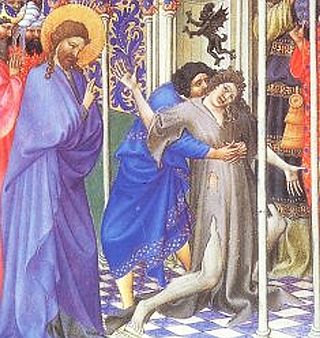
In English translations of the Bible, unclean spirit is a common rendering of Greek pneuma akatharton, which in its single occurrence in the Septuagint translates Hebrew ruaḥ tum'ah.

Healing the centurion's servant is one of the miracles performed by Jesus of Nazareth as related in the Gospel of Matthew and the Gospel of Luke. The story is not recounted in the Gospels of either John or Mark.

The exorcism of the Gerasene demoniac, frequently known as the Miracle of the (Gadarene) Swine and the exorcism of Legion, is one of the miracles performed by Jesus according to the New Testament. The story shows Jesus exorcising a demon or demons out of a man and into a herd of swine, causing the swine to run down a hill into a lake and drown themselves.

Jesus healing the bleeding woman is one of the miracles of Jesus recorded in the synoptic gospels.

The Calling of Matthew is an episode in the life of Jesus which appears in all three synoptic gospels, Matthew 9:9–13, Mark 2:13–17 and Luke 5:27–28, and relates the initial encounter between Jesus and Matthew, the tax collector who became a disciple.
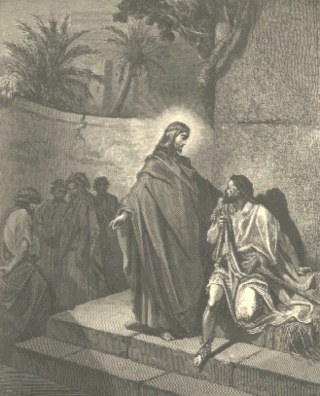
In Christianity, exorcism involves the practice of casting out one or more demons from a person whom they are believed to have possessed. The person performing the exorcism, known as an exorcist, is often a member of the Christian Church, or an individual thought to be graced with special powers or skills. The exorcist may use prayers and religious material, such as set formulas, gestures, symbols, icons, or amulets. The exorcist often invokes God, Jesus, angels and archangels, and various saints to aid with the exorcism. Christian exorcists most commonly cast out demons in Jesus' name.
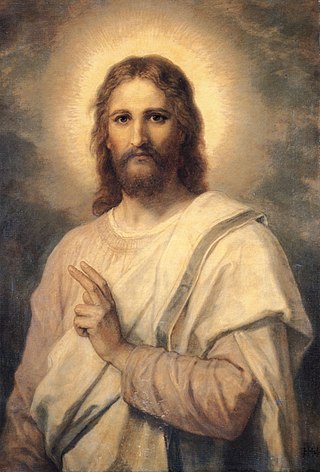
The following outline is provided as an overview of and topical guide to Wikipedia articles on the life and influence of Jesus.
